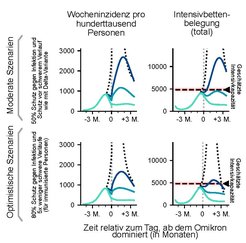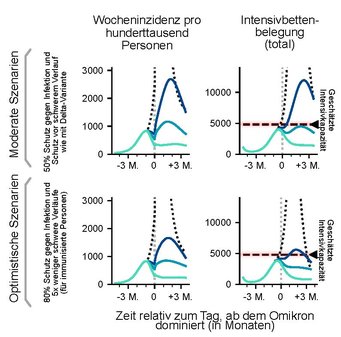Effects of behavior and risk perception on the spread of COVID-19
Voluntary and mandatory contact reductions, as well as hygiene measures and vaccination jointly determine how quickly COVID-19 spreads. Yet, the individual health-protective behavior is not constant, but partly triggered by risk perception based on current and past developments of the pandemic. A multidisciplinary team of scientists from epidemiology, sociology, and psychology joined forces to tackle this challenge, incorporating data-driven insights into their modeling framework. They show that a well-chosen intermediate level of mandatory non-pharmaceutical interventions, can result in well-adjusted voluntary health-protective actions. This can change the course of the pandemic, also in the light of the new Omicron variant. Among the interdisciplinary research team are Viola Priesemann, from the Max Planck Institute for Dynamics and Self-Organization and the University of Göttingen, André Calero Valdez from RWTH Aachen University, Mirjam Kretzschmar from the University Medical Center Utrecht, Kai Nagel from the Technische Universität Berlin, and Michael Mäs from the Karlsruhe Institute of Technology.
Given all the sources of uncertainty inherent to human nature, modeling the interplay of human behavior and disease spread is one of the grand challenges of infectious disease modeling. In their new work, the scientists show how in different scenarios the population's behavior in the face of the pandemic situation influences the spread of COVID-19. The scientists conclude that, given sufficient population immunity, mandatory restrictions need to be tailored to an appropriate level in order to avoid a mere delay of the pandemic with subsequent infection waves. If they are chosen too weak or too strong, such restrictions could limit the room for behavioral adaptation to the actual risk level, which may lead to a rebound wave once restrictions are lifted. The researchers found that generally risk awareness among the population can dampen a wave of infections significantly. Without such a feedback loop, incidences could rise to a level of thousands new infections daily per million people.
Different possible scenarios for the course of COVID-19 spreading

Considering the spread of the novel Omicron variant, the interdisciplinary research team illustrates several scenarios for the development of case numbers and ICU occupancy. Given the uncertainties on the effectiveness of booster vaccination against infection, transmission, and severity for the Omicron variant, these scenarios may change considerably when more information becomes available. Yet, in every but the most optimistic scenario, restrictions would have to be increased further to avoid overburdening the health system. Even if this new variant required a smaller fraction of infected individuals to receive intensive care, without further restrictions, the infection numbers could rise tremendously, leading to many people being in quarantine at the same time. Due to local outbreaks or large regional infection clusters, the quarantine requirements could severely affect the normal functioning of critical infrastructure. A lack of workforce even in this comparably optimistic scenario is concerning as it may exacerbate daily life and supplies. “One has to remember that this model already includes the effect that people will be more careful once hospitalization is high. Thus, it does not merely assume that the population’s behavior remains the same”, says Philipp Dönges from the Max Planck Institute for Dynamics and Self-Organization, first author of the study. In the optimistic case of a strongly reduced virulence of Omicron for immunized people, the sheer number of simultaneous infections could pose a problem to society, and in particular to hospitals.
Implications of the new Omicron variant
The depicted possible scenarios and their consequential conclusions were based on current knowledge and figures on the Omicron variant. The study can already be accessed online, but is still undergoing the peer-review process for publication in a scientific journal.The data basis for the study includes, among others, age-dependent hospitalization rates, vaccination willingness, and contact structures, waning immunity and different levels of mandatory restrictions. For the Delta variant, many of the immunological parameters are already well known. For the Omicron variant, in contrast, the uncertainty is still considerable. "Within the uncertainty, our resulting forecast on the dynamics of the Omicron variant are similar to those of many other researchers in Germany and abroad, with whom we are in close contact. This active exchange among researchers is extremely helpful and reassuring for us.", says Viola Priesemann, who coordinated the study. Within the next few weeks the uncertainty on Omicron transmission and severity will decrease, and we will be able to further narrow down the range of likely scenarios. "Within all the potential scenarios for Omicron, we obviously hope that the best one will apply", concludes André Calero Valdez.
